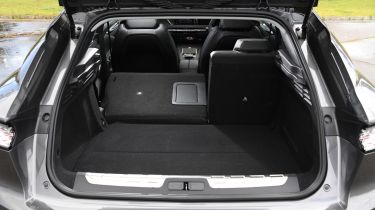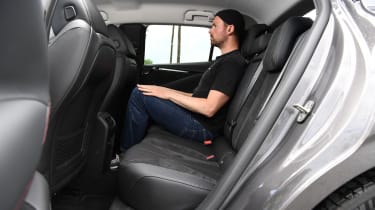DS 4 review - Practicality, comfort and boot space
With a big boot and lots of useful practical touches, the DS 4 hatchback should fit well into family life

DS has made comfort a priority for its 4 hatchback, with all models featuring high-density foam seats, front and rear centre armrests, a steering wheel with reach and rake adjustment, and acoustic glass, which helps to reduce outside noise. Practical touches include rear parking sensors, power folding heated door mirrors, automatic headlights and wipers, two USB-C ports in the front of the cabin and a 60:40-split folding rear bench seat.
Upgrading to the top-spec Opera trim adds an automatic tailgate, a wireless smartphone charging function and front seats with heating, ventilation and massaging functions.
During our testing we found that while the front seats have a reasonable amount of side support, the high dash line means you need to jack the base up to get a decent view. The views both over the shoulder and out of the small back window are poor, too.
Size
The DS 4 is 4,400mm long, 1,830mm wide and stands 1,470mm tall, which means it occupies a slightly bigger footprint than an Audi A3. A Mercedes A-Class is 19mm longer, while less-premium hatchbacks such as the Ford Focus and Vauxhall Astra are around 20 to 25mm shorter.
Leg room, head room & passenger space
Rear passengers in the DS 4 are well catered for – head, knee and elbow room are all within a few millimetres of what the A-Class offers in the back, but the DS 4’s seats are more comfortable and supportive. The DS 4’s stylish low roofline does impact on headroom a little, while the central rear seat is pretty narrow and raised, which means taller occupants may find it more difficult to find a comfortable position.
Fitting a child seat is a little more fiddly in the DS compared to the A-Class too, because the French hatchback's ISOFIX mounts are tucked behind zipped slits in the upholstery.
|
Rear seat space comparison | |||
|
Knee room (min-max) |
Headroom |
Elbow room | |
|
DS 4 |
575-836mm |
914mm |
1,390mm |
|
Mercedes A-Class |
563-817mm |
920mm |
1,425mm |
Boot
The DS 4 petrol and diesel models have a 430-litre boot capacity, which is 50 litres more than an Audi A3 hatchback and 60 litres over a Mercedes A-Class. Fold the 60:40 split rear seats down and you have access to 1,240 litres of load space. Choosing the plug-in hybrid version means sacrificing a little carrying capacity, because it offers 390 litres – although this is still much better than an A3 PHEV, which can only muster 280 litres.
When we opened up the boot of the DS 4 to compare it to the A-Class’s in our twin test, we found that while the DS has a wider boot space, the Mercedes has the advantage by offering a lower lip and longer load area.
|
Boot space comparison | |||
|
Length |
Width |
Lip height | |
|
DS 4 |
782mm |
1,098mm |
729mm |
|
Mercedes A-Class |
817mm |
1,038mm |
642mm |
Towing
Buyers should go for a diesel model if they plan on regularly towing a trailer or small caravan. This has the highest maximum braked trailer weight, at 1,500kg, followed by the plug-in hybrid, which is capable of pulling up to 1,400kg, and the PureTech 130 petrol on 1,100kg.










